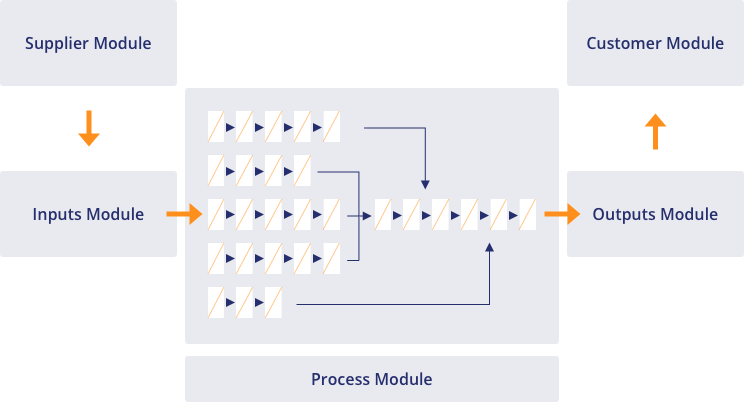Lean Six Sigma, Lean & Six Sigma: A Definitive Guide

Welcome to our definitive guide to Lean, Six Sigma & Lean Six Sigma. We have broken up this content into eight sections which you can click on the links below to skip ahead or continue reading for the full guide.
- What is Lean Six Sigma?
- The Benefits of Lean Six Sigma
- What is Lean?
- The Lean Roadmap
- What is Six Sigma?
- Lean Vs Six Sigma
- How to Chose the Right Methodology
- [VIDEO] How to Think About Lean Six Sigma
What is Lean Six Sigma?
Lean Six Sigma is quite simply the integration of Lean and Six Sigma methodologies to reduce waste, defects (variation) and increase effectiveness and results. Lean focuses on efficiency, and Six Sigma focuses on how effectiveness can lead to faster results.
Together, they are more powerful than either method applied independently of the other. A successful Lean Six Sigma deployment is dependent on a clear understanding of the roles, responsibilities, structures and training requirements of the employee.
Roots of Lean Six Sigma
Lean Six Sigma can be traced back to 1986, at Motorola in the United States. Ever since World War II Japan was experiencing an economic boom through the implementation of the Kaizen business model, and Japanese products were considered to be of a higher quality than American products as a result. Therefore, Lean Six Sigma was created to compete with the Kaizen business model.
Lean Six Sigma originated from the Juran Trilogy; an approach to planning, controlling and improving performance in an organization. The Trilogy utilizes projects to focus on achieving breakthroughs in current levels of performance through design or improvement methods. Breakthroughs do not just happen, they require a systematic change process, one that can be achieved with the “project-by-project” approach.
Once a new product, service or process is designed or improved, the outcomes must be controlled to hold the gains. This is done through a quality control process and the root cause corrective action method.
Improving products, processes, and services is a never-ending pursuit. Achieving breakthroughs may require a tenfold improvement, or even better than 3.4 parts per million, which is a Six Sigma level.
For an organization to continue making breakthroughs and meet the needs of their stakeholders, they must master the skills to plan, control, and improve quality. To do this they must use Yellow Belts, Green Belts, Black Belts, and Master Black Belts who follow the Lean Six Sigma methodology.
Benefits of Lean Six Sigma
Lean and Six Sigma – or Lean Six Sigma – provide a comprehensive set of methods and tools that enable organizations to improve quality and reduce costs; all for the ultimate goal of continuous value creation for the customer. Certainly, these are strategic advantages for any company. However, there are five additional benefits that Lean Six Sigma companies enjoy:
Strategic Planning
Strategic planning is driven by an organization’s mission and vision statements, with the mission statement focused on why the organization exists and the vision statement articulating what the organization hopes to achieve. The very best strategic plans translate the vision statement to quantifiable and measurable objectives, such as increasing market share or reducing employee turnover. Lean Six Sigma can accelerate the pace at which those objectives are achieved.
Productivity
As organizations reduce waste and variation from their processes, the noticeable effect is that it increases employee productivity. This happens for several reasons. First, with less waste and less variation, there is less rework. When you get it right the first time, you don’t spend time fixing errors.
Employee Satisfaction
With increased employee productivity comes increased employee motivation, as well as higher employee satisfaction. Employees who don’t have to fight through poorly designed processes, devise workarounds to get things done, or spend time on non-value-adding steps, are more motivated and happier. This isn’t the only employee benefit. As organizations embed Lean Six Sigma into the fabric of their companies, employees naturally become more attuned to identifying waste and variation, as well as seeking opportunities to improve quality and create additional customer value.
Customer Loyalty
Imagine a company that was adept at creating customer value, reducing defects, reducing variation in its products and services, increasing features and benefits, offering a high variety of options at little to no additional cost, and increasing the speed at which the products and services were delivered. That company would certainly enjoy high customer satisfaction, which translates to equally high customer loyalty and retention.
Supply Chain Management
What mature Lean Six Sigma companies usually discover, is that to continuously improve processes, suppliers must eventually become integrated into their quality improvement initiatives. To fully reduce waste and variation in your processes, your suppliers must reduce the waste and variation in their processes, too.
What is Lean?
Lean is a process improvement methodology used to optimize organizational systems by eliminating or reducing common types of “waste” within them. It does this so organizations perform faster, cheaper and better by improving cycle time and throughput.
Anything that does not offer value is considered waste. Lean methods and tools can provide significant improvements in organizational efficiency. Lean has experienced a continual rebirth in manufacturing-based industries, as well as in service and healthcare-based organizations.
The concept of Lean was developed by Toyota executive, Taiichi Ohno, who first identified the seven types of muda (waste). From there, the Toyota Production System was born, followed by multiple other improvement processes such as World Class Manufacturing (WCM).
Lean, therefore, is typically based on the Toyota Production System and seeks to minimize waste, shorten lead times, and maximize efficiency.
In summary, Lean:
- Reduces lead time
- Increases throughput
- Eliminates waste
- Provides more value to customers
- Creates greater profitability
- Improves delivery time
Lean Methodology – The Roadmap
Lean uses the same DMAIC methodology as Six Sigma, which is an acronym of five phases:
- Define
- Measure
- Analyze
- Improve
- Control
The difference with Lean, however, is that you use this step-by-step methodology on an entire process as opposed to a specific chronic problem. The Lean DMAIC roadmap goes as follows:
-
Define Value
- Define stakeholder value and CTQs
- Define customer demand
- Map high-level process
- Assess for 6S implementation
-
Measure Value
- Measure customer demand
- Plan for data collection
- Validate the measurement system
- Create a value stream map
- Determine pace, takt time, and manpower
- Identify replenishment and capacity constraints
- Implement S1-S3 of 6S
-
Analyze Process Flow
- Analyze the value stream map
- Analyze process and load capacity
- Perform VA/NVA decomposition analysis
- Apply Lean problem solving to solve for special causes
-
Improve Process Pull
- Conduct rapid improvement events
- Design the process changes and flow
- Feed, balance, and load the process
- Standardize work tasks
- Implement new processes
-
Control the Process
- Stabilize and refine the value stream
- Complete process and visual controls
- Identify mistake-proofing opportunities
- Implement S4-S6 of 6S
- Monitor results and close out the project
A Lean expert working with subject matter experts attempts to understand the “value streams” (the end-to-end process tasks that add value to the good or service produced when combined together). They then synchronize processes with customer demand, which enables them to drive out the eight common wastes in processes:
- Overproducing
- Waiting
- Transport
- Poor process design
- Inventory
- Motion
- Defects
- Underutilized personnel and creativity
The Value Stream in Lean Six Sigma
- Lean Six Sigma projects can begin by selecting a problem to solve or a value stream to improve.
- A value stream differs from a problem-solving activity. It is more encompassing because it includes all the activities required to bring goods or services from conception to commercialization.
- A value stream can include detailed design, order taking, scheduling, processing, and delivery or a subset of it.
- Understanding the value stream allows you to see value-added steps, non-value added steps, and non-value added, but necessary, steps.

What is Six Sigma?
Six Sigma typically focuses on identifying and meeting the needs of customers first, and the organization or business second. In this way, revenues increase and costs decrease; ultimately improving results.
Six Sigma is about improving what is important or “Critical to the customer (CTQs).” We call this the “Y.” Here, the equation Y = f(x) is used to guide the team and help communicate what a project is trying to accomplish.
Once we understand what the Ys are, we then measure them to see if we are meeting the target. We analyze the Ys to understand the process characteristics that cause variation, and then reduce their variation by controlling the process variables. We call these variables the “Xs.”
There may be many Xs that can impact the Y. If Y is a function of X, then all we need to do is define the Xs with enough precision to control them. Once controlled, the Y should be met. Once this is done we can then hold the gains to maintain performance.
Y = f (x1, x2, x3, x4,…)
Lean Vs Six Sigma
Lean is not a replacement for Six Sigma, and vice versa, because they both take different approaches in the quest for greater effectiveness, efficiency and cost reduction. Essentially, they focus on different problems.
For instance, Lean starts by analyzing workflow and defining value in terms of the benefits the customer gains from the goods or services that are produced. It is conducted in Rapid Improvement or Kaizen events instead of projects.
Alternatively, Six Sigma is focussed on eliminating defects and waste to improve quality and efficiency. This will not only streamline processes but will also achieve a higher level of customer satisfaction.
Six Sigma and Lean have become two of the most widely recognized and effective methods for creating breakthrough improvement. Both have also evolved from the basis of prior methods, such as Dr. Juran’s Universal Sequence for Breakthrough Quality Improvement, Dr. Shewhart’s and Dr. Deming’s PDCA Cycle and, as mentioned, Toyota’s specialized focus on driving out waste.
Lean and Six Sigma are separate yet complementary methods for improvement. When used independently, Six Sigma allows project teams to improve the effectiveness of processes, while Lean helps improve process efficiency. When used together, the two can both be fit into the DMAIC model to create a new process which is both effective and efficient; driving out waste while increasing value.
Choosing Methodologies
Whether with the customer-based approach of Six Sigma, or the more speed-focused strategy of Lean, many organizations around the world are succeeding in achieving performance breakthroughs where they had failed before. This is even more-so the case for organizations through the combination of both into the Lean Six Sigma methodology. Smart companies recognize this as not simply a “fix” to one-time problems, but truly a new way of doing business.
Your organization must not debate which to do first, but rather determine how to do both. When you do, you will join the ranks of many globally successful companies. Organizations worldwide are under continuing pressure to control costs, maintain high levels of safety and quality, and meet growing customer expectations. This breakthrough improvement process has been adopted by many large organizations, like Samsung Electronics, General Electric and smaller organizations, like Molex (electronics), A. Schulman (plastics), J. R. Simplot (food processing), and Highmark (insurance) to name a few, as the most effective method for achieving their goals.

Author: Dr. Joseph A DeFeo
Dr. Joseph A. DeFeo, Chairman and CEO of Juran, is recognized as one of the world’s leading experts on transformational change and breakthrough quality management.
For 28 years, Dr. DeFeo has worked as a trusted adviser helping business leaders increase sales, reduce costs and improve its customer experience through the deployment of performance excellence programs. These include Business Process Quality Management, Lean, Six Sigma, Strategy Deployment and Change Management. His recent publication, Juran’s Quality Essentials for Leaders, provides a concise message delivered for leaders to teach them how to embrace quality, not fight it, to be a globally competitive enterprise. Dr. DeFeo has co-authored three other popular texts.
DeFeo’s belief that a relentless customer focus and integrity drives business results was recently noted by Steve Denning of Forbes.com. A frequent motivational guest speaker at international conferences, Dr. DeFeo has presented in over 30 countries.





